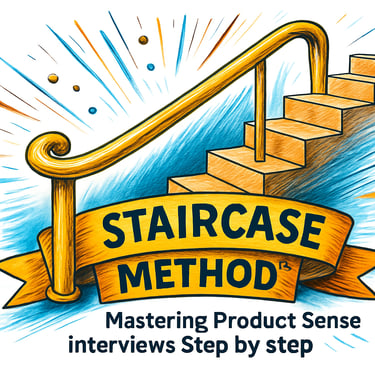The Staircase Method℠: Mastering Product Sense Interviews Step by Step
How to navigate product sense interviews with confidence using the goal as your handrail.
Mark Rose
7/3/20255 min read
Product sense interviews can feel overwhelming. You're faced with an abstract prompt like "Design a product for investing" and suddenly you need to demonstrate structured thinking, customer empathy, and product intuition—all while maintaining a coherent narrative that impresses your interviewer.
The secret to success lies in understanding what I call the Staircase Method—a systematic approach that treats product sense interviews like climbing a staircase, with your goal serving as a handrail to guide you safely to the top.
The Product Sense Staircase
Imagine a staircase with distinct steps, each one building on the last:
Clarifying Questions - Understanding the prompt
Mission & Context - Connecting to company strategy
Goal Setting - Defining what success looks like
Ecosystem & Market - Understanding the landscape
Segmentation - Choosing your target user
Pain Points & Desires - Identifying problems to solve
Solutions - Building your product
Why the Staircase Metaphor Works
You can't skip steps. Just like a real staircase, if you skip any one of these steps, you're going to stumble. The interview structure requires each step to build logically on the previous one.
You can only see the next step. When you start a product sense interview, you genuinely don't know where you'll end up. And that's exactly how it should be. The magic happens when you trust the process and focus on nailing each individual step.
The journey creates the destination. Your final solution will be something you never could have imagined at the start—and that's what makes it authentic and compelling.
The Goal: Your Handrail to Success
Here's where most candidates go wrong: they treat the goal as just another step to get through quickly. In reality, your goal is the most important element of the entire interview—it's your handrail that guides you safely up every step.
What Makes a Great Goal
A strong goal has three characteristics:
Connected to company mission - Shows you understand strategic context
Specific to the prompt - Demonstrates you're solving the right problem
Actionable - Provides clear direction for every subsequent step
Example from the investing product case:
Weak goal: "Help people invest better"
Strong goal: "Build the future of connected investing" (ties to Meta's mission of human connection)
Using Your Goal as a Handrail
Once you've established your goal, you hold onto it throughout the entire interview:
During segmentation: "Given our goal of connected investing, let's focus on young first-time investors who need social support for financial decisions."
During pain points: "Looking at pain points through the lens of connected investing, the biggest issue is that young investors feel alone when making financial decisions."
During solutions: "Our solution needs to create connections between investors while helping them make better financial decisions."
The goal becomes your through line—ensuring every step connects logically and your final solution actually addresses what you set out to solve.
Step-by-Step Breakdown
Step 1: Clarifying Questions
Purpose: Understand the scope and context
Key questions:
What's driving this initiative?
Any constraints on timeline, market, or approach?
How does this fit with existing products?
Pro tip: Don't spend too long here—3-4 strategic questions maximum.
Step 2: Mission & Context
Purpose: Connect your solution to company strategy
What to do: Explicitly state how this product fits the company's mission
Example: "Meta's mission is building the future of human connection, and investing decisions are inherently social—people ask neighbors and friends for advice."
Step 3: Goal Setting
Purpose: Create your handrail for the entire interview
Framework: [Company Mission] + [Specific Prompt] = [Your Goal]
Critical success factor: Make it specific enough to guide decisions but broad enough to allow exploration
Step 4: Ecosystem & Market
Purpose: Understand the landscape without getting lost in details
Approach: Quickly map key players, acknowledge complexity, then focus on your target
Time allocation: Keep this brief—it's context, not the main event
Step 5: Segmentation
Purpose: Choose your ideal customer
Framework: Create 3-4 segments on the same axis, evaluate on reach/impact, pick one
Common mistake: Mixing different types of segmentation (age + behavior + geography)
Step 6: Pain Points & Desires
Purpose: Identify specific problems to solve
Key insight: Pain points drive engagement, desires drive adoption
Goal check: Ensure your pain points align with your overarching goal
Step 7: Solutions
Purpose: Design your product Approaches:
Chicken/Beef/Pork: Three distinct solution approaches. Stay tuned for a future post on this...
MVP/Roadmap/Vision: Current solution with future expansion. Stay tuned for a future post on this...
Critical rule: Be feature-first, implementation-second
The Engineer's Trap (And How to Avoid It)
There's a dangerous pattern that derails many product sense interviews, especially with engineering candidates. Here's how it works:
The Prompt: "Design a product for X"
The Instant Solution: Their eyes light up—they immediately know the answer
The Tortuous Journey: They spend 45 minutes trying to justify their pre-conceived solution
The Broken Process: Every step is reverse-engineered to support their initial idea
The problem: Even if their solution is good (and it often is), they haven't shown their work. It's like a broken clock being right twice a day—the outcome might be correct, but the process is fundamentally flawed.
The solution: When you get a product sense prompt and a solution immediately pops into your head, beat it down with a two-by-four. Trust the staircase process instead.
Common Mistakes and How to Fix Them
Mistake #1: Skipping the Goal
Problem: Treating goal-setting as a throwaway step
Fix: Spend real time crafting a goal that connects mission to prompt
Result: Every subsequent step becomes easier and more coherent
Mistake #2: Premature Solution Mode
Problem: Jumping to features before understanding the problem
Fix: Trust that solutions will emerge naturally from pain points
Result: More authentic, well-reasoned products
Mistake #3: Losing the Thread
Problem: Each step feels disconnected from the last
Fix: Explicitly reference your goal during transitions between steps
Result: A coherent narrative that builds naturally
Mistake #4: Implementation-First Thinking
Problem: Focusing on "how to build" before "what to build"
Fix: Design the user experience first, worry about technical details later
Result: Solutions that actually solve user problems
The Magic of Trusting the Process
Here's what's remarkable about the Staircase Method: when you trust the process and focus on each individual step, you end up with solutions you never could have imagined at the start.
Real example from the investing case:
Started with: "Design a product for investing"
Ended with: A social investing platform that puts young investors in groups based on goals and preferences, with AI-powered content and automated investing, creating a feedback loop of social sharing about financial progress
That specific solution emerged naturally from working through each step systematically. It wasn't planned—it was discovered.
Practical Tips for Implementation
Before the Interview
Memorize the steps: Practice until the staircase becomes second nature
Prepare transition phrases: "Now that we've identified our target segment, let's explore their pain points..."
Practice goal crafting: Get comfortable connecting company missions to various prompts
During the Interview
Start every step with a transition: Explicitly state why you're moving to the next step
Reference your goal regularly: Use it to make decisions and maintain focus
Trust the uncertainty: Not knowing where you're going is a feature, not a bug
Show your work: Explain your reasoning at each step
Managing Time
Clarifying questions: 3-5 minutes
Mission/Context/Goal: 5-7 minutes
Segmentation: 8-10 minutes
Pain points: 8-10 minutes
Solutions: 15-20 minutes
Wrap-up: 2-3 minutes
When You Know You've Mastered It
You'll know you've mastered the Staircase Method when:
You feel comfortable with uncertainty - Not knowing the final solution feels natural
Your goal drives decisions - Every choice connects back to your handrail
Solutions emerge organically - Your final product feels like an inevitable conclusion
You enjoy the journey - The interview becomes a collaborative exploration rather than a test
Beyond Product Sense: The Broader Application
The Staircase Method isn't just for interviews—it's how great product managers actually work:
Strategic planning: Building from mission to execution
Problem-solving: Working systematically through complex challenges
Stakeholder communication: Creating clear, logical narratives
Product development: Ensuring every feature connects to user needs
When you master this approach for interviews, you're also building skills that will make you a better product manager in practice.
The Bottom Line
Product sense interviews test your ability to take an abstract concept and systematically develop it into a coherent product vision. The Staircase Method gives you a reliable framework for this process, while the goal-as-handrail ensures you maintain focus and coherence throughout.
Remember: the objective isn't to show what you know—it's to show how you think. The Staircase Method demonstrates structured thinking, user empathy, and the ability to build logically from strategy to execution.
Trust the process. Focus on each step. Hold onto your handrail. And watch as compelling product solutions emerge naturally from systematic thinking.
The staircase is always there—you just need to take it one step at a time.


Copyright 2024. All rights reserved. Privacy Policy. Refunds and Cancelations. Terms and Conditions.


